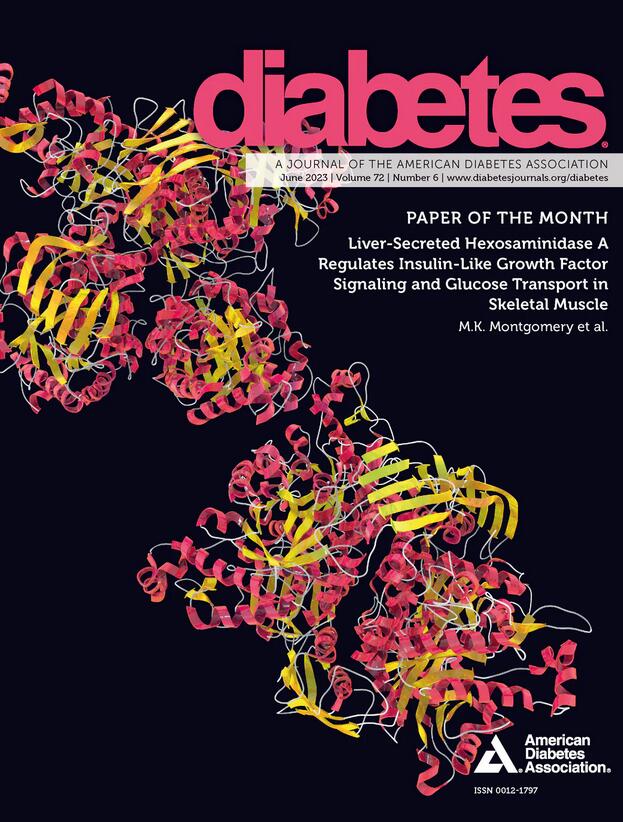1822-LB:糖尿病行动家庭支持(FAM-ACT)与传统糖尿病管理教育和支持随机比较效果试验
IF 6.2
1区 医学
Q1 ENDOCRINOLOGY & METABOLISM
引用次数: 0
摘要
导言:家庭支持对于维持糖尿病自我管理教育/支持(DSMES)的成果至关重要,尤其是对于社会经济地位较低的西班牙裔成年糖尿病患者(AWD)而言。糖尿病自我管理教育/支持缺乏让支持者(SP)参与的结构化方法。我们的目标是确定 FAM-ACT 的有效性,FAM-ACT 是一项 DSMES 计划,主要针对 AWD-SP 二人组,而 DSMES 则针对单个 AWD,均由社区保健工作者提供,并为西班牙裔 AWD 量身定制。方法:在一家为西语裔人口提供服务的 FQHC 中,患有 T2D 且 A1C ≥7.5% 的成年患者与一名成年 SP 一起注册;随机选择 FAM-ACT 或 DSMES,然后邀请他们在 6 个月内参加 6 次课程。每节 FAM-ACT 课程都包括关于支持 AWD 糖尿病管理的 SP 培训。在基线、6 个月和 12 个月时测量糖尿病患者的 A1C。主要结果是 6 个月的 A1C 变化,采用线性混合模型进行分析。结果:在 222 个报名参加的糖尿病患者-专业人员二人组中,糖尿病患者的平均年龄为 52 岁(标准差 10),38% 为男性,82% 喜欢西班牙语,39% 具有高中或以上学历。助教的平均年龄为 45 岁(标准差 13),47% 是助教的配偶/伴侣,26% 是成年子女,27% 是兄弟姐妹/朋友/其他人。AWD平均完成3.8次/6次疗程,FAM-ACT治疗组的SP平均完成2.7次/6次疗程。在 ITT 分析中,DSMES 6 个月的 A1C 下降幅度大于 FAM-ACT(-0.97% vs. -0.42%,p=0.06),但在 12 个月时,两者的下降幅度相似(DSMES -0.55%,FAM-ACT -0.65%,p=0.77)。在基于AWD和SP的CACE分析中,FAM-ACT 6个月的A1C降幅为-1.32%,而DSMES为-0.89%,P=0.59;12个月后,FAM-ACT的降幅保持不变(-1.23%,而DSMES为-0.47%,P=0.63)。结论在低社会经济地位的西班牙裔成年人中,FAM-ACT 在降低 6 个月 A1C 方面的效果不如传统的 DSMES,但在项目结束 6 个月后,FAM-ACT 的 A1C 继续得到改善,而传统的 DSMES 则有所下降。当支持者与患者一起参与 FAM-ACT 计划时,AWD 在临床上的改善幅度明显更大,而且持续时间更长。披露 A. Rosland:无。G. Piatt:无。E.C. Kieffer:无:无。F. Valbuena:无:无。G. Palmisano:无。S. Perez:无。J. Yabes:其他关系;拜耳公司M. Heisler:无。国家糖尿病、消化道和肾脏疾病研究所 (R01DK116733) 资助本文章由计算机程序翻译,如有差异,请以英文原文为准。
1822-LB: Family Support for Diabetes Action (FAM-ACT) vs. Traditional Diabetes Management Education and Support—Randomized Comparative Effectiveness Trial
Introduction: Family support can be crucial to sustaining gains from diabetes self-management education/support (DSMES), especially for low SES Hispanic adults with diabetes (AWD). DSMES lacks structured approaches to engaging support persons (SP). Our objective was to determine the effectiveness of FAM-ACT, a DSMES program focused on AWD-SP dyads vs DSMES with individual AWD, both CHW-delivered and tailored to Hispanic AWD. Methods: Adult patients with T2D and A1C ≥7.5% at an FQHC serving a Hispanic population were enrolled with an adult SP; dyads were randomized to FAM-ACT or DSMES, then invited to 6 sessions over 6 months. Each FAM-ACT session included SP training on supporting AWD diabetes management. AWD A1C was measured at baseline, 6 and 12 months. The primary outcome was 6-month change in A1C, analyzed using linear mixed models. Results: Among 222 AWD-SP dyads enrolled, AWD were mean age 52 years (SD 10), 38% men, 82% preferred Spanish language, 39% had a high school degree or more. SPs were mean age 45 (SD 13), 47% were the AWD’s spouse/partner, 26% adult child, and 27% sibling/friend/other. AWD completed mean 3.8/6 sessions, and SP in FAM-ACT arm 2.7/6. In ITT analyses, A1C 6-month decline was greater in DSMES than FAM-ACT (-0.97% vs. -0.42%, p=0.06) but at 12 months, they were similar (DSMES -0.55%, FAM-ACT -0.65%, p=0.77). In Complier Average Causal Effect (CACE) analyses based on AWD and SP with at least average expected session attendance, FAM-ACT 6 month A1C decline was -1.32% vs DSMES -0.89%, p=0.59 and at 12 months FAM-ACT had sustained decline (-1.23% vs -0.47% DSMES, p=0.63). Conclusion: FAM-ACT was less effective at lowering 6-month A1C than traditional DSMES among low SES Hispanic adults, however FAM-ACT A1C continued to improve 6 months after the program ended while traditional DSMES gains regressed. When supporters engaged with patients in FAM-ACT, AWD had clinically significantly larger improvements that were sustained. Disclosure A. Rosland: None. G. Piatt: None. E.C. Kieffer: None. F. Valbuena: None. G. Palmisano: None. S. Perez: None. J. Yabes: Other Relationship; Bayer Inc. M. Heisler: None. Funding National Institute of Diabetes and Digestive and Kidney Diseases (R01DK116733)
求助全文
通过发布文献求助,成功后即可免费获取论文全文。
去求助
来源期刊

Diabetes
医学-内分泌学与代谢
CiteScore
12.50
自引率
2.60%
发文量
1968
审稿时长
1 months
期刊介绍:
Diabetes is a scientific journal that publishes original research exploring the physiological and pathophysiological aspects of diabetes mellitus. We encourage submissions of manuscripts pertaining to laboratory, animal, or human research, covering a wide range of topics. Our primary focus is on investigative reports investigating various aspects such as the development and progression of diabetes, along with its associated complications. We also welcome studies delving into normal and pathological pancreatic islet function and intermediary metabolism, as well as exploring the mechanisms of drug and hormone action from a pharmacological perspective. Additionally, we encourage submissions that delve into the biochemical and molecular aspects of both normal and abnormal biological processes.
However, it is important to note that we do not publish studies relating to diabetes education or the application of accepted therapeutic and diagnostic approaches to patients with diabetes mellitus. Our aim is to provide a platform for research that contributes to advancing our understanding of the underlying mechanisms and processes of diabetes.
 求助内容:
求助内容: 应助结果提醒方式:
应助结果提醒方式:


